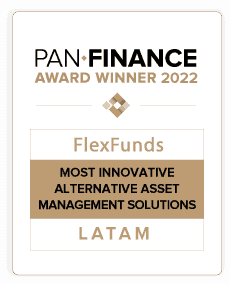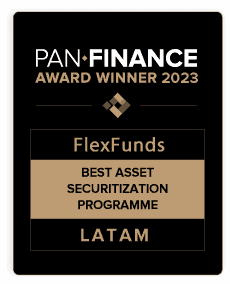- This article explores how ETFs can contribute to investment portfolio diversification and risk reduction in the financial market.
- The information contained in this article is useful for portfolio managers and investment advisors who are considering ETFs as a financial instrument to optimize their investment strategy and goals.
- FlexFunds specializes in setting up and issuing innovative and customized investment vehicles similar to ETFs. If you want to delve deeper into the products developed by FlexFunds and find the solution that best suits your needs, feel free to contact our team of specialists.
While any investment in the financial market always involves assuming a level of risk, portfolio managers have a wide range of tools to manage and reduce that risk. One of those tools, which has gained growing popularity and appeal in recent years, is Exchange Traded Funds (ETF), which provide an effective and efficient way to diversify an investment portfolio. In this way, they can help improve the risk-return relationship by enhancing long-term performance and/or reducing risk.
What are ETFs?
ETFs are investment funds that trade on the stock exchange and represent ownership of a diversified set of underlying assets, such as stocks, bonds, commodities, specific sectors, or even entire indices. Unlike traditional mutual funds, ETFs are traded on the stock exchange like individual stocks, allowing investors to buy and sell ETFs at any time during market trading hours, just like ordinary shares.
The main feature that sets ETFs apart is their structure, as each one is composed of a portfolio of underlying assets that reflects a specific index or investment strategy. For example, an ETF tracking the S&P 500 index would contain a selection of the stocks that make up that index, and its performance would closely mirror that of the S&P 500 as a whole.
The broad range of assets that an ETF can be exposed to allows for extensive diversification, reducing the risk compared to concentrating investments in a single stock or industry. To achieve this, various strategies can be implemented to enhance diversification and reduce risks.
10 Potential ETF Management Strategies
It is advisable to understand the risks associated with investing in ETFs in order to develop a specific strategy in line with the investor’s objectives and profile. You can receive specialized advice on how set up an investment vehicle, similar to ETF from the team of experts at FlexFunds, whom you can consult.
Among the main strategies to consider, the following stand out:
1. Portfolio Diversification
This is the most classic strategy and is key to reducing risk in an investment portfolio. When assets are distributed across different classes, industrial sectors, and geographic regions, the negative impact of poor performance in a specific investment is mitigated. ETFs offer an effective way to achieve this diversification.
In this way, portfolio managers can adjust their portfolio according to their economic expectations and opinions on different sectors.
2. Asset Diversification
Concentrating a portfolio in a single asset or a small group of assets exposes it to significant risk. ETFs allow asset managers to build their investment strategy with a wide range of asset classes without having to buy and manage them individually. For example, there are ETFs that track equity indices, commodities, government bonds, corporate bonds, or real estate, among others, depending on investment goals.
This asset diversification can be especially valuable when it comes to reducing risk because investing in an ETF that covers multiple assets within a category dilutes the impact of poor performance by one asset, helping to reduce the overall portfolio risk.
3. Industrial Sector Diversification
Sector-specific ETFs allow investment advisors to focus on specific segments of the economy, such as technology, healthcare, energy, or finance, among others. By adding ETFs from different sectors to the portfolio, they can reduce exposure to specific risks in a given industry.
4. Geographic Diversification
Regional and global ETFs offer exposure to different markets and geographic regions, which is essential for reducing dependence on a single market and seizing opportunities worldwide. ETFs tracking indices of emerging and developed markets are common examples of this strategy.
5. Investment Strategy Diversification
Some ETFs are designed to follow specific strategies, such as value, growth, quality, or sustainable investing, allowing portfolio managers to diversify according to their investment goals and style.
6. Market Capitalization Diversification
ETFs that track companies of different capitalization sizes, such as large, mid, or small-cap, can help balance the portfolio. Companies of different sizes can behave differently in different market conditions, which can help smooth portfolio volatility. In fact, the volatility of large-cap stocks is often lower than that of small-cap stocks, although numerous studies show that the long-term performance of the latter tends to outperform the former.
7. Bond Diversification
Bond ETFs offer a way to diversify within the fixed-income asset class, where portfolio managers can choose compositions that track a wide variety, such as government bonds, corporate bonds, regional bonds, municipal bonds, or high-yield bonds, depending on their needs and investment goals. In times of market uncertainty and high interest rates, this can be a good option to balance a portfolio.
8. Hedging and Risk Reduction Strategies
Hedging strategies aim to protect or reduce risk in portfolio management, and some ETFs are designed with this in mind. Examples include volatility ETFs that seek to mitigate market fluctuations or inverse ETFs that move in the opposite direction of a specific index to hedge existing positions.
9. Sustainable Investment Strategies
ETFs that track sustainable investment indices allow asset managers to align their strategies with their ethical and environmental values, a trend that has gained popularity and shown significant growth in the markets. This can be a way to diversify the portfolio and mitigate risks related to environmental, social, and corporate governance (ESG) issues.
10. Restructuring Strategy
Once diversification has been implemented in the portfolio using ETFs, it is essential to regularly monitor and rebalance the asset allocation to maintain the desired portfolio distribution. This involves selling assets that have increased in value and buying assets that have decreased to maintain the desired portfolio distribution.
Advantages of Diversification through ETFs
In addition to risk diversification, diversifying the portfolio through ETFs offers several additional advantages that asset managers should consider, and these have become the main advantages favoring their growth. Among them, the following stand out:
- Liquidity and Availability
ETFs trade on the stock exchange, which means they can be bought and sold during market trading hours, providing high liquidity and flexibility to adjust the portfolio according to market conditions and investor needs.
- Transparency
ETFs publish their underlying portfolio daily and trade on the markets in real-time. They are also regulated, providing complete visibility into the assets that comprise them and their prices. This transparency allows for greater clarity in investment decision-making.
- Low Fees
In general, ETFs tend to have lower costs compared to traditional mutual funds, as they typically have lower expense ratios, which means improved net returns for portfolio managers who can choose to pass on this efficiency to their clients.
- Immediate Diversification
By investing in a single ETF, advisors and investors gain instant access to a diversified portfolio of assets. This saves time and effort in selecting and managing individual assets.
- Tax Efficiency
ETFs tend to be tax-efficient. Due to their unique structure, they offer flexible tax mechanisms that can reduce tax obligations for investors in certain jurisdictions, thus potentially reducing long-term tax implications.
ETFs are a powerful tool that allows portfolio managers to diversify their portfolios and reduce risk. This diversification capability is essential for prudent portfolio management. Furthermore, taking advantage of the other mentioned benefits allows for the design of more robust, resilient portfolios tailored to long-term financial goals.
However, it is important to remember that no investment strategy is risk-free, and thorough research and careful consideration of risk tolerance are essential before investing in any ETF or diversified portfolio.If you are an investment advisor looking to issue an investment vehicle similar to an ETF, you can contact our team of experts who will provide personalized advice.







